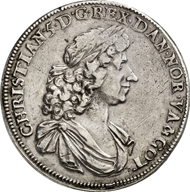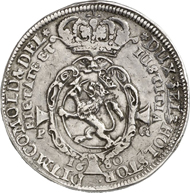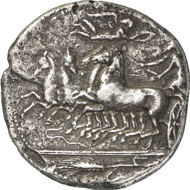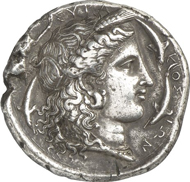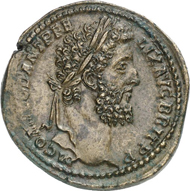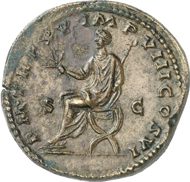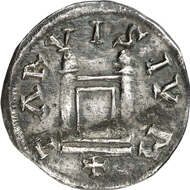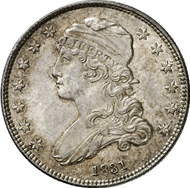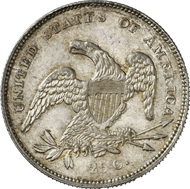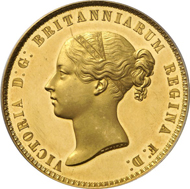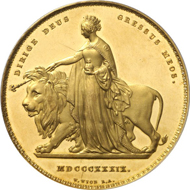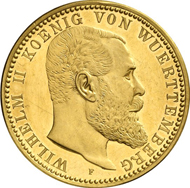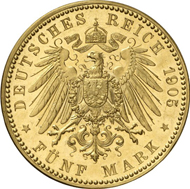07-10-2012 – 11-10-2012
Auctions 216-218
An Amazing 130,000 EUR for a Quadruple Thaler of Christian V of Norway at Künker
The outcome of the Osnabrück fall auction turned out to be unexpectedly high: instead of the 6.1 million EUR estimated, overall final sale prices totalled an astounding 8.4 million, an increase of over 35 percent. Roughly 5,500 lots were sold between October 8th through 12th, and a mere 277 items not sold in the room went into post-auction sale. Collectors and dealers alike were quite literally spoiled for choice: once again, the three catalogues, 216 through 218, offered outstanding material, some of it also very rare.
2954: NORWAY. Christian V (1670-1699). Thick, quadruple speziesthaler, 1680. Dav. A 3654. Of greatest rarity, very fine. Estimate: 50,000 EUR. Final Price: 130,000 EUR.
The real showstopper, however, came in the form of a quadruple thaler of King Christian V of Norway – it went to an unknown telephone bidder for an amazing 130,000 EUR.
The action got underway with the roughly 1,600 ancient numbers from catalogue 216. All told, they brought in an impressive 3.3 million EUR in overall final sales, eclipsing the estimate of 2.6 million. The suspense and excitement was palpable right from the outset – a Pannonian tetradrachm estimated at 300 EUR went for 2,600 EUR, and a second piece far surpassed its estimate of 750 EUR to go for a final price of 5,500 EUR!
Not to be outdone, the Greek coins managed some impressive leaps of their own. Take, for example, an exceedingly rare bronze coin from Populonia, which climbed all the way from 150 to 2,800 EUR …
163: SYRACUSE. Tetradrachm, 415/405. Tudeer 66. From the Kunstfreund Collection. RR, very fine / nearly extremely fine. Estimate: 10,000 EUR. Final Price: 50,000 EUR.
… or, perhaps, a classic tetradrachm from Syracuse, once part of the Kunstfreund Collection, which outdid itself fivefold, reaching a very substantial 50,000 EUR. A gold stater from Panticapeum featuring a satyr and gryphon made another sizeable jump, from 40,000 to 80,000 EUR.
Moving right along to the Roman coins, there are a number of outstanding aureii that beg reporting. Deciding exactly which ones to briefly mention here is no easy feat! Domitian’s aureus from the year 82 definitely needs to be included (Estimate 20,000 EUR, Final price 42,000 EUR), as does Hadrian’s from 134/138, depicting lovely portraits of him, Trajan and Plotina (Estimate 35,000 EUR, Final Price 40,000 EUR), and the splendid aureus featuring the portrait of Faustina II (Estimate 7,500 EUR, Final Price 12,000 EUR).
1082: ROME. Commodus (177-192). Sestertius, 190. BMC 652. Brown patina, extremely fine. Estimate: 1,500 EUR. Final Price: 5,000 EUR.
It would seem that even allegedly ‘non-precious’ items too can achieve ‘precious’ results, as shown by a sestertius of Commodus from the year 190 estimated at 1,500 EUR that sold for 5,000.
There were over 2,600 lots from Medieval and Modern Times featured in catalogue 217, with a total volume of 1.7 million EUR. Growth rates of over 50 percent, however, yielded an overall final total of 2.7 million EUR. A fitting example from the medallions section is the silver medallion from the stamps of the great royal seal of the Danish sovereign Frederick III. (1648-1670) – the hammer came down at 21,000 EUR for this very rare piece (Estimate 15,000 EUR). The Middle Ages truly shone with bracteates, among others, from Meissen, as well as with Carolingians.
2107: CAROLINGIANS. Louis the Pious (814-840). Denarius. CNI VI, S. 229, 1 and plate XXII, 1. Depeyrot 1079 F. M./G. 452. Second-known specimen, very fine. Estimate: 10,000 EUR. Final Price: 14,000 EUR.
The second-known denarius from Treviso of Louis the Pious, for example, easily left its estimate of 10,000 EUR in the dust, reaching a final price of 14,000 EUR. Ludwig’s youngest son, Charles the Bold, once had a penny minted in Aix-la-Chapelle. For a final price of 4,200 EUR (Estimate 3,000 EUR), the very rare coin finally returned to its hometown, likely to be on display there sometime in the near future. The highest final price of the auction week, however, was realized by the 1680 quadruple thaler of the Norwegian king Christian V – estimated at 50,000 EUR, it sold for 130,000.
3390: USA. 25 cents (1/4 Dollar), 1831. Yeo. 2009. Nearly FDC. Estimate: 2,500 EUR. Final Price: 17,000.
Fractions should clearly not be underestimated! This is further evidenced by the price realized by a 25-cent U.S. coin from 1831 – it started off at 2,500 EUR only to finish at the substantially higher 17,000 EUR.
Catalogue 218 comprised roughly 850 gold pieces that reached an overall final yield of 1.85 million EUR instead of the expected 1.4 million. Of special mention here is a golden solidus of Louis the Pious (814-840) featuring a portrait, which changed hands for 16,000 EUR (Estimate 20,000 EUR).
5193: GREAT BRITAIN. Victoria (1837-1901). 5 pounds, 1839, “Una and the Lion.” Seaby 3851. RR, PP. Estimate: 40,000 EUR. Final Price: 75,000 EUR.
Also of note is an 1839 5-pound coin depicting Britain’s Queen Victoria as a lion tamer – this magnificent piece (‘Una and the lion’) was to be had for 75,000 EUR instead of the estimated 40,000. In 1937, King Victor Emmanuel III of Italy had fewer than 1,000 specimens minted of a gold coin of 100 lira. This particular specimen, although estimated at 20,000 EUR, ultimately sold for 30,000. Let’s throw in a German example as well: a Hamburg bank portugaloeser of 10 ducats from 1689 improved on its estimate of 15,000 EUR to go for 24,000 EUR.
Things ended with about 300 German coins from after 1871. They sold for a good 500,000 EUR (Estimate 370,000 EUR). The rare 1875 20-mark piece of Reuss, Elder Line, went for a final price of 30,000 EUR (Estimate 28,000 EUR). A true stunner of the same denomination from Saxe-Meiningen from 1882 was sold for 26,000 EUR (Estimate 15,000 EUR).
6170: WURTEMBERG. William II (1891-1918). 5 marks, 1905. J. 176. Of great rarity, PP. Estimate: 10,000 EUR. Final Price: 26,000 EUR.
Even with minute scratches, the Wurtemberg golden five-mark piece from 1905 in proof still managed to far outdo its estimate of 10,000 EUR, going instead for the much higher 26,000 EUR.
There were also smaller denominations on offer, interesting trial pieces and a wide selection of other very attractive lots in all three catalogues. The result list is available here.





